Is it possible to ride an electric dirt bike on the road? At usabikers.net, we understand the thrill of riding and the desire to explore both on and off the beaten path. The short answer is yes, but there are considerations. Understanding the requirements is key to legally enjoying your electric dirt bike on public streets. Let’s explore the world of electric dirt bikes and their road legality, and provide a comprehensive guide to ensure your ride is safe, legal, and enjoyable. Prepare to learn about electric motorcycle laws, street legal dirt bikes, and electric dirt bike modifications.
1. What Determines if an Electric Dirt Bike Can Be Street Legal?
An electric dirt bike can be street legal if it meets specific requirements similar to Class 4 e-bikes, but without pedals, it also must adhere to local regulations regarding safety and equipment. Street legality hinges on several crucial factors, including lighting, tires, mirrors, safety equipment, and vehicle identification.
1.1 Lighting
Street-legal motorcycles require headlights, taillights, brake lights, and turn signals to ensure visibility and safety on public roads. Electric dirt bikes often lack these features, making them unsuitable for street use without modifications.
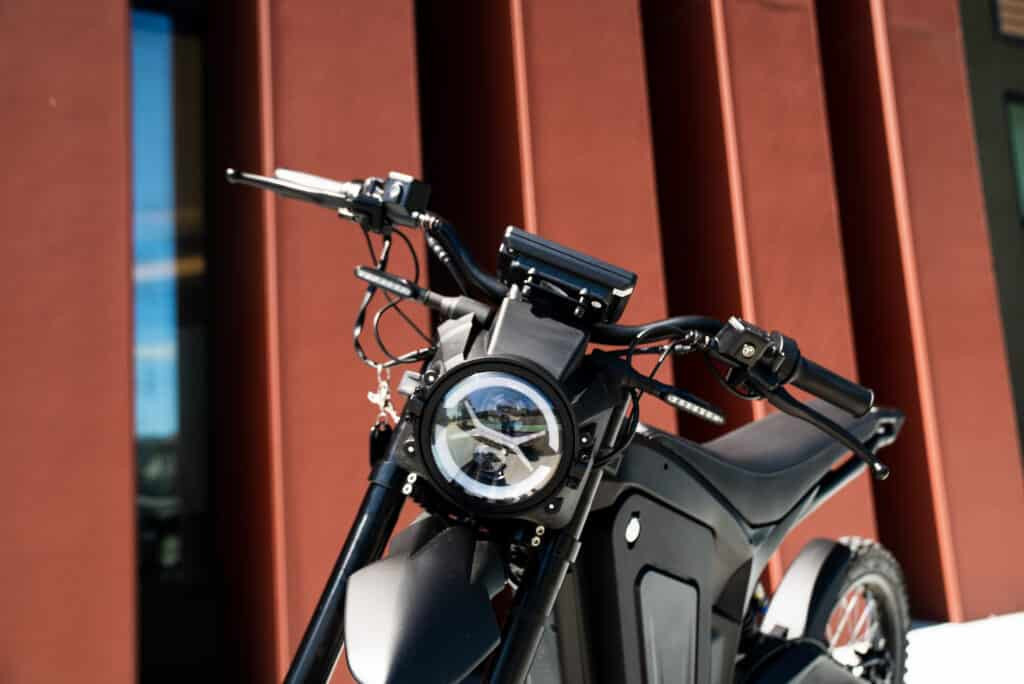 Electric Dirt Bike Lighting
Electric Dirt Bike Lighting
1.2 Tires
Off-road dirt bikes typically have knobby tires designed for traction on uneven terrain. These tires may not provide the necessary grip and stability required for safe street riding. Many off-road electric bikes can be purchased with tires designed for road riding, or road tires can be mounted after purchase to enhance safety and handling on paved surfaces.
1.3 Side Mirrors
Street-legal motorcycles must have rearview mirrors to provide riders with a clear view of the traffic behind them. Electric dirt bikes may not come equipped with mirrors, which can pose a safety risk on public roads. Ensure mirror attachments are available for your bike to make it street legal and improve your awareness of surrounding vehicles.
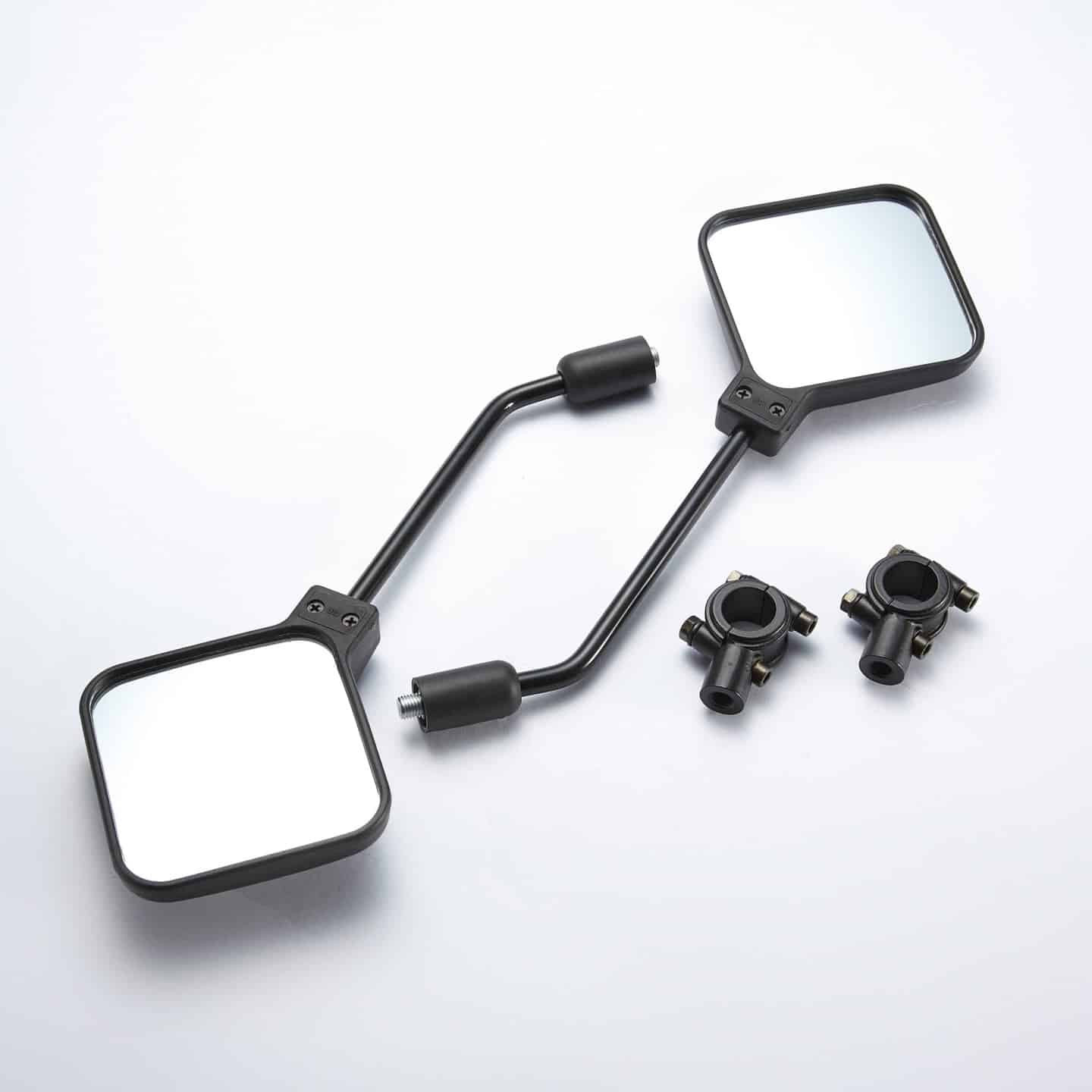 Electric Dirt Bike Side Mirror
Electric Dirt Bike Side Mirror
1.4 Additional Safety Equipment
Street-legal motorcycles must have safety features such as a horn, speedometer, and a license plate holder. These features ensure that riders can effectively communicate with other road users, comply with speed limits, and display proper identification. Electric dirt bikes may lack these typical road safety features, making them non-compliant with road traffic laws unless modifications are made.
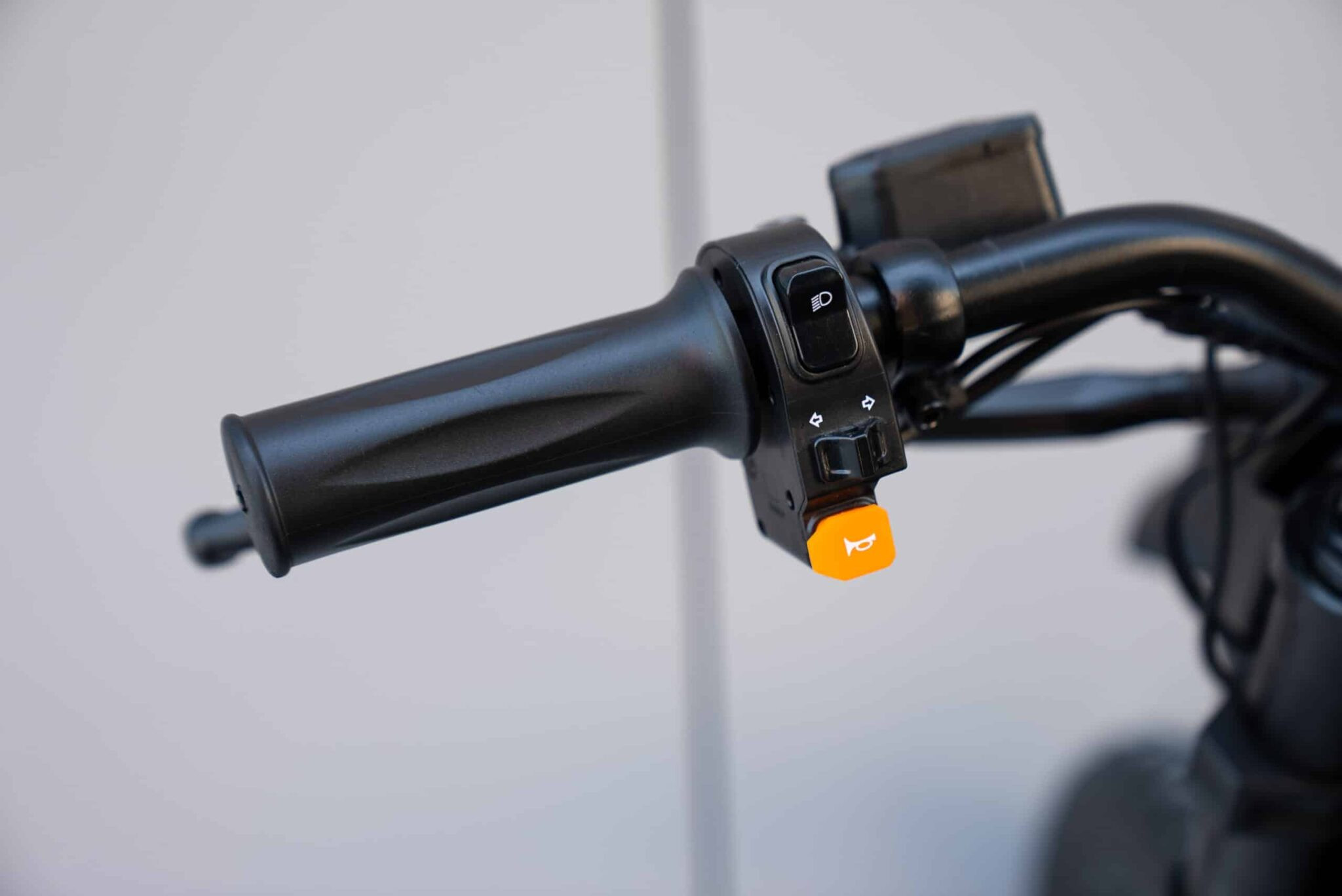 Electric Dirt Bike Turn Signals
Electric Dirt Bike Turn Signals
1.5 Vehicle Identification Number (VIN)
Just like cars, all street-legal motorcycles must have a VIN (vehicle identification number) so they can be registered with the DMV. If you’re shopping around for a road-worthy electric dirt bike, check with the manufacturer to ensure it has a VIN, which is essential for legal registration and identification.
2. What Electric Dirt Bikes are Street Legal and Worth Considering?
Several electric dirt bikes come with features that make them street-legal or easily convertible for road use. These models offer a blend of off-road capability and on-road compliance, making them versatile choices for riders.
2.1 Solar E-Clipse
The Solar E-Clipse, a 72V carbon-frame champ, boasts a Rider Guide-tested top speed of 57.8 mph and a tested range of 61.3 miles. It features a swappable battery to keep you going and comes with optional road tires, making it a roadworthy bike perfect for longer commutes.
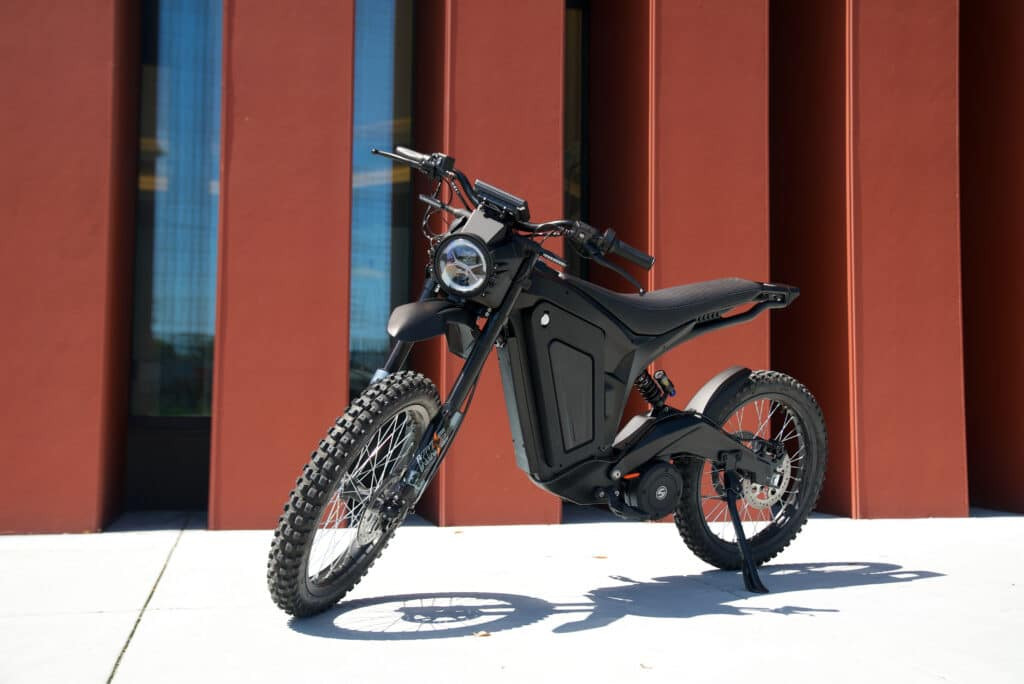 Solar E-Clipse Electric Dirt Bike
Solar E-Clipse Electric Dirt Bike
2.2 Sur Ron Light Bee X
Surron has become a top name in electric dirt bikes, and the 60V, 104-pound, street-legal Light Bee X is one of the reasons why. With a top speed of 45 mph and a range of 40 to 60 miles, this bike is excellent for commuting around town and can be made street legal with mirror attachments and registration.
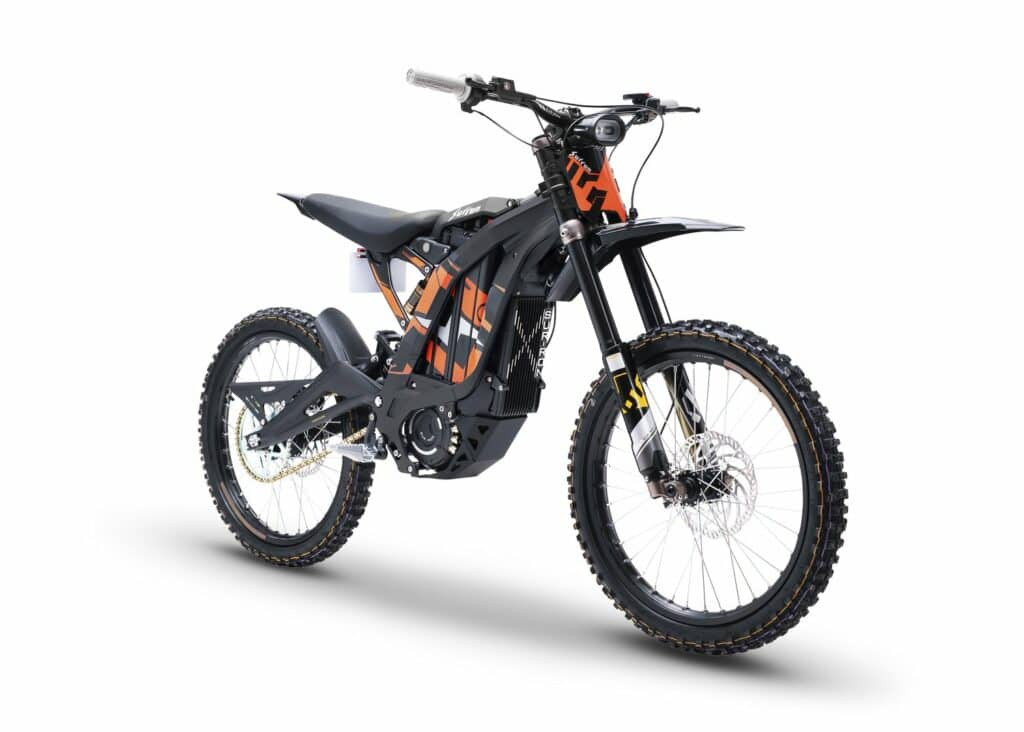 Sur Ron Light Bee X Electric Dirt Bike
Sur Ron Light Bee X Electric Dirt Bike
2.3 Sur Ron Storm Bee
The Surron Storm Bee, a beast of an off-road bike, comes in a street-legal version with a 96V battery and 150V controller. This configuration allows modders to swap in an even more high-powered battery. In its current configuration, the Storm Bee can hit a 68 mph top speed and travel up to 60 miles on a single charge.
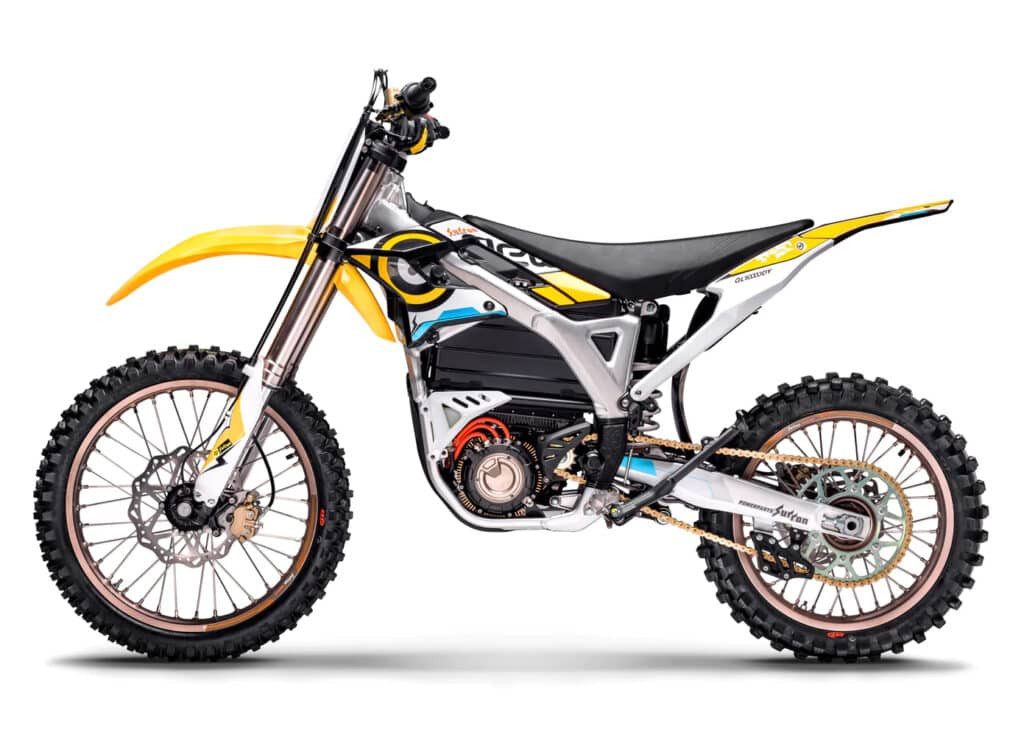 Sur Ron Storm Bee Electric Dirt Bike
Sur Ron Storm Bee Electric Dirt Bike
2.4 Zero FX
With a range of about 90 miles, the Zero FX can hit a maximum speed of 85 mph. Although mainly built for off-road adventures, the FX is also a street-legal electric bike with lean, mean roadworthy capabilities.
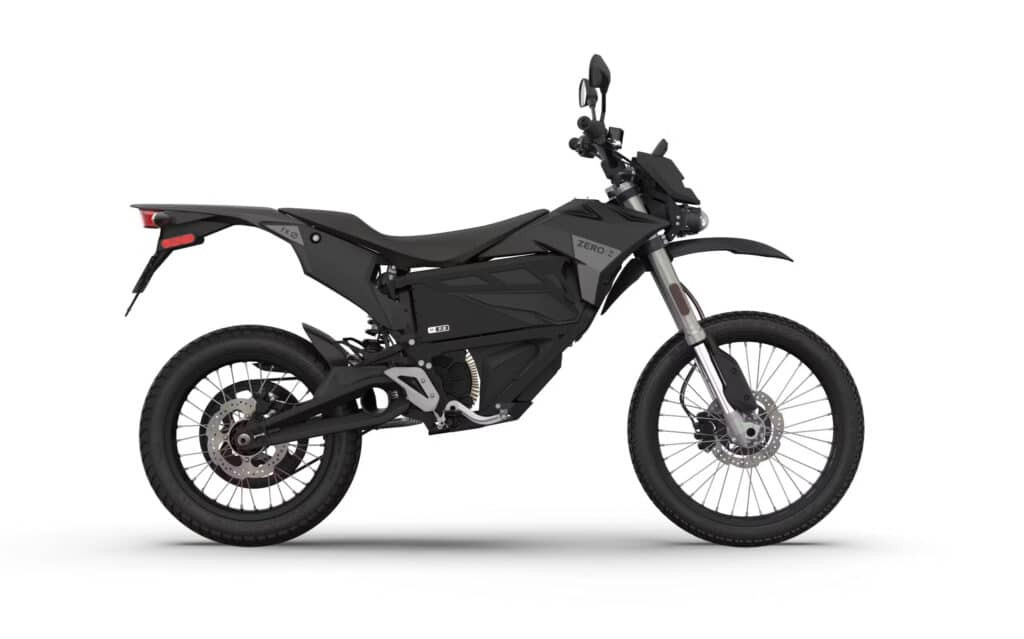 Zero FX Electric Dirt Bike
Zero FX Electric Dirt Bike
2.5 Cake Kalk INK&
Cake’s unique designs for their Kalk series of bikes make them look like nothing else, but they ride like top-class electric motorcycles, both on and off-road. The only street-legal bike in the lineup, the Kalk INK& promises top speeds of 55 mph and above.
 Cake Kalk INK Electric Dirt Bike
Cake Kalk INK Electric Dirt Bike
3. What are the Steps to Convert an Electric Dirt Bike for Street Use?
Converting an off-road electric bike for road use typically involves several modifications and additions to meet the road safety standards set by your local authorities. These steps will help ensure your electric dirt bike is street legal and safe for public roads.
3.1 Check Local Legal Requirements
Start by understanding the specific regulations for converting and operating electric dirt bikes on streets in your region. This will help you determine the necessary modifications and documents required. Contacting your local Department of Motor Vehicles (DMV) or transportation authority is essential to get precise details on state and local laws. According to the American Motorcyclist Association (AMA), regulations vary significantly by state, so knowing your local laws is the first step.
3.2 Install Lighting and Signaling Systems
Install the required lighting and signaling systems, including headlights, taillights, brake lights, turn signals, and reflectors. These additions will make your bike more visible to other road users, ensuring your safety. Ensure the lights meet Department of Transportation (DOT) standards.
3.3 Obtain a License Plate and Registration
Ensure your electric dirt bike has a VIN. Obtain a license plate and register your electric dirt bike with the appropriate authorities. This step is crucial to ensure that your bike is legally recognized and can be identified if necessary.
3.4 Install Mirrors and a Horn
Install rearview mirrors to enhance your visibility on the road. Additionally, equip your bike with a horn to alert other drivers when necessary. These additions are critical for safe street riding.
3.5 Check Tires and Wheels Compliance
Check if your electric dirt bike’s tires and wheels comply with road safety standards. You may need to replace them with appropriate street-legal alternatives. Ensure that the tires are rated for street use and can handle the speeds you intend to reach.
 Electric Dirt Bike Seat
Electric Dirt Bike Seat
3.6 Licensing and Insurance
In some areas, you may need to acquire additional licensing, such as a motorcycle license, and insurance coverage specific to electric dirt bikes operating on public roads. Check with your local DMV to determine the specific licensing requirements.
3.7 Adhere to Speed Limitations
Some jurisdictions impose speed limitations on electric dirt bikes when riding on streets. Adhering to these limitations will help you stay within the legal framework and ensure a safe riding experience. Always be aware of the posted speed limits and adjust your speed accordingly.
4. Why is Understanding the Legal Landscape Important for Electric Dirt Bikes?
Understanding the legal landscape is crucial for electric dirt bike riders to ensure compliance, safety, and responsible operation. Navigating regulations and laws surrounding electric dirt bikes can prevent legal issues and promote safe riding practices.
4.1 Avoiding Fines and Penalties
Operating an electric dirt bike on public roads without proper registration, insurance, or required safety equipment can result in fines, penalties, and potential impoundment of the vehicle. Compliance with local regulations helps riders avoid these legal consequences.
4.2 Ensuring Safety on Public Roads
Street-legal requirements such as lighting, mirrors, and appropriate tires are in place to enhance safety for both the rider and other road users. Understanding and adhering to these requirements minimizes the risk of accidents and promotes responsible riding.
4.3 Promoting Responsible Riding
Familiarizing oneself with local laws and regulations encourages responsible riding behavior, including respecting speed limits, traffic laws, and pedestrian safety. This contributes to a positive image of electric dirt bike riders and fosters community acceptance.
4.4 Protecting Rider Rights
Knowledge of legal rights and responsibilities empowers riders to advocate for fair treatment and access to public spaces. Understanding the legal landscape enables riders to engage in constructive dialogue with authorities and policymakers.
4.5 Contributing to Policy Development
Informed riders can actively participate in the development of regulations and policies related to electric dirt bikes. By providing input and feedback to lawmakers, riders can help shape legislation that balances safety, environmental concerns, and rider freedoms.
5. What are the Key Safety Considerations for Riding Electric Dirt Bikes on the Road?
Riding an electric dirt bike on the road requires careful consideration of safety to protect yourself and others. Prioritizing safety measures can significantly reduce the risk of accidents and injuries.
5.1 Protective Gear
Always wear appropriate protective gear, including a DOT-approved helmet, eye protection, gloves, and sturdy riding boots. Protective gear provides crucial protection in the event of a crash or fall.
5.2 Visibility
Ensure your electric dirt bike is equipped with functioning headlights, taillights, brake lights, and turn signals to enhance visibility, especially during low-light conditions or at night. Consider wearing reflective clothing to increase visibility to other road users.
5.3 Defensive Riding Techniques
Practice defensive riding techniques such as maintaining a safe following distance, scanning the road for potential hazards, and anticipating the actions of other drivers. Be prepared to react to unexpected situations and avoid aggressive maneuvers.
5.4 Tire Condition and Pressure
Regularly inspect your tires for wear, damage, and proper inflation. Maintain the recommended tire pressure to ensure optimal handling and braking performance.
5.5 Brake Inspection and Maintenance
Check your brakes regularly to ensure they are functioning properly. Replace worn brake pads and cables promptly to maintain reliable stopping power.
5.6 Familiarization with Bike Controls
Before riding on the road, familiarize yourself with the controls and operation of your electric dirt bike. Practice basic maneuvers such as turning, braking, and accelerating in a controlled environment.
5.7 Awareness of Road Conditions
Pay attention to road conditions such as potholes, gravel, and uneven surfaces that can affect your bike’s handling. Adjust your speed and riding style to accommodate changing road conditions.
5.8 Weather Considerations
Be mindful of weather conditions such as rain, snow, or ice that can reduce traction and visibility. Avoid riding in hazardous weather conditions whenever possible.
5.9 Avoid Distractions
Refrain from using electronic devices or engaging in other distractions while riding. Keep your focus on the road and your surroundings to ensure a safe riding experience.
5.10 Regular Maintenance
Perform regular maintenance on your electric dirt bike, including checking and lubricating chains, inspecting wiring and electrical connections, and ensuring all components are in good working order.
6. How Do State and Local Laws Affect the Legality of Electric Dirt Bikes on Roads?
State and local laws play a significant role in determining the legality of electric dirt bikes on public roads. Regulations vary widely across jurisdictions, impacting registration, licensing, equipment requirements, and operational restrictions.
6.1 Classification of Electric Dirt Bikes
Many states classify electric dirt bikes similarly to electric bicycles (e-bikes) or motorcycles, which influences the applicable laws and regulations. Some states may have specific classifications for electric dirt bikes based on power output, top speed, or other characteristics.
6.2 Registration and Licensing Requirements
Depending on the classification, electric dirt bikes may be subject to registration and licensing requirements similar to motorcycles. This may involve obtaining a title, registering the vehicle with the state’s Department of Motor Vehicles (DMV), and obtaining a license plate.
6.3 Equipment Requirements
State and local laws often mandate specific equipment requirements for electric dirt bikes operating on public roads. These requirements may include headlights, taillights, brake lights, turn signals, mirrors, horns, and other safety features.
6.4 Speed Limits and Restrictions
Some jurisdictions impose speed limits and restrictions on electric dirt bikes to promote safety and manage traffic flow. These restrictions may vary depending on the type of road, location, and classification of the vehicle.
6.5 Helmet Laws
Many states have helmet laws that require riders of motorcycles and similar vehicles to wear protective helmets. Depending on the classification of electric dirt bikes, these helmet laws may apply to riders.
6.6 Local Ordinances and Restrictions
Local cities, counties, and municipalities may have additional ordinances and restrictions governing the operation of electric dirt bikes on public roads. These local regulations can vary significantly and may impact where and how riders can legally operate their vehicles.
6.7 Enforcement and Penalties
State and local law enforcement agencies are responsible for enforcing traffic laws and regulations related to electric dirt bikes. Violations of these laws may result in fines, penalties, vehicle impoundment, and other legal consequences.
6.8 Consistency and Reciprocity
Variations in state and local laws can create confusion and challenges for riders traveling across jurisdictions. Efforts to promote consistency and reciprocity in regulations may help streamline compliance and facilitate interstate travel.
7. How Can Riders Stay Updated on Changing Electric Dirt Bike Laws?
Staying informed about changing electric dirt bike laws is essential for riders to ensure compliance and avoid legal issues. Utilizing available resources and staying engaged with regulatory updates can help riders remain knowledgeable and responsible.
7.1 Monitor Government Websites
Regularly check official government websites, such as the Department of Motor Vehicles (DMV) and state transportation agencies, for updates on laws and regulations related to electric dirt bikes. These websites often provide information on new legislation, amendments, and enforcement policies.
7.2 Subscribe to Legal Newsletters
Sign up for legal newsletters and email alerts from legal organizations, advocacy groups, and industry associations that cover electric vehicle laws and regulations. These newsletters can provide timely updates and analysis of legal developments.
7.3 Attend Public Hearings and Meetings
Participate in public hearings, town hall meetings, and legislative sessions where electric vehicle laws are discussed and debated. Attending these events allows riders to voice their opinions, ask questions, and gain insights into the policymaking process.
7.4 Engage with Advocacy Groups
Join or support advocacy groups and organizations that represent the interests of electric vehicle riders. These groups often track legislative developments, lobby for favorable policies, and provide educational resources to their members.
7.5 Consult Legal Professionals
Consult with attorneys, legal experts, and consultants specializing in electric vehicle law for personalized guidance and advice. Legal professionals can help riders interpret complex regulations and navigate legal challenges.
7.6 Network with Other Riders
Connect with other electric dirt bike riders through online forums, social media groups, and local riding clubs. Sharing information and experiences with fellow riders can help you stay informed about legal developments and best practices.
8. What Role Does the American Motorcyclist Association (AMA) Play in Electric Dirt Bike Legality?
The American Motorcyclist Association (AMA) plays a crucial role in shaping the landscape of electric dirt bike legality through advocacy, education, and policy development. The AMA works to promote the interests of motorcyclists and protect their rights while advocating for responsible riding practices.
8.1 Legislative Advocacy
The AMA actively engages in legislative advocacy at the federal, state, and local levels to influence laws and regulations affecting motorcyclists, including electric dirt bike riders. The AMA lobbies for fair and reasonable policies that balance safety, environmental concerns, and rider freedoms.
8.2 Policy Development
The AMA develops policy positions and recommendations on issues related to motorcycling, including electric vehicle technology, safety standards, and access to public lands. These policies provide guidance to lawmakers and regulatory agencies in crafting effective legislation.
8.3 Educational Resources
The AMA provides educational resources and training programs to promote safe riding practices and enhance rider awareness. These resources cover topics such as motorcycle safety, traffic laws, and environmental stewardship.
8.4 Rider Representation
The AMA represents the interests of motorcyclists and electric dirt bike riders in discussions with government officials, industry stakeholders, and community organizations. The AMA serves as a voice for riders, advocating for their rights and concerns.
8.5 Collaboration with Industry
The AMA collaborates with motorcycle manufacturers, aftermarket companies, and industry associations to promote innovation, safety, and sustainability in the motorcycling industry. This collaboration helps shape the development of electric dirt bike technology and related products.
8.6 Promotion of Responsible Riding
The AMA promotes responsible riding behavior among motorcyclists and electric dirt bike riders, emphasizing the importance of wearing protective gear, obeying traffic laws, and respecting the environment. The AMA encourages riders to be ambassadors for motorcycling and uphold a positive image of the sport.
9. What are the Benefits of Riding Street Legal Electric Dirt Bikes?
Riding street-legal electric dirt bikes offers numerous benefits, combining the thrill of off-road riding with the convenience and practicality of on-road transportation. These advantages make street-legal electric dirt bikes an attractive option for riders seeking versatility and enjoyment.
9.1 Versatility
Street-legal electric dirt bikes offer versatility by allowing riders to transition seamlessly between off-road trails and public roads. This versatility makes them ideal for exploring diverse terrain and commuting in urban environments.
9.2 Cost Savings
Electric dirt bikes have lower operating costs compared to traditional gasoline-powered motorcycles. Electricity is often cheaper than gasoline, and electric bikes require less maintenance due to fewer moving parts.
9.3 Environmental Friendliness
Electric dirt bikes produce zero emissions, reducing air pollution and minimizing their environmental impact. This makes them a sustainable transportation option for environmentally conscious riders.
9.4 Quiet Operation
Electric dirt bikes operate quietly, reducing noise pollution and minimizing disturbance to natural environments. This makes them suitable for riding in residential areas and sensitive ecosystems.
9.5 Fun and Excitement
Street-legal electric dirt bikes provide a fun and exciting riding experience, with instant torque, responsive handling, and nimble maneuverability. Riders can enjoy the thrill of off-road adventures while still having the convenience of on-road capabilities.
9.6 Access to Public Roads
Street-legal electric dirt bikes can legally access public roads, allowing riders to commute to work, run errands, and explore local communities without the need for a separate vehicle.
9.7 Reduced Maintenance
Electric dirt bikes require less maintenance compared to gasoline-powered motorcycles. There are no oil changes, spark plugs, or air filters to replace, reducing maintenance costs and downtime.
9.8 Government Incentives
Many governments offer incentives such as tax credits, rebates, and subsidies for electric vehicle purchases, making street-legal electric dirt bikes more affordable for consumers.
10. What is the Future of Electric Dirt Bikes and Their Legality?
The future of electric dirt bikes and their legality looks promising, with ongoing advancements in technology, evolving regulations, and growing acceptance of electric vehicles. Several trends and developments are shaping the trajectory of electric dirt bikes in the years to come.
10.1 Technological Advancements
Continued advancements in battery technology, motor design, and vehicle engineering are improving the performance, range, and reliability of electric dirt bikes. These advancements are making electric dirt bikes more competitive with traditional gasoline-powered motorcycles.
10.2 Regulatory Harmonization
Efforts to harmonize regulations and standards for electric vehicles at the state, national, and international levels are streamlining compliance and promoting market growth. Consistent regulations reduce confusion and barriers to entry for manufacturers and consumers.
10.3 Expansion of Charging Infrastructure
The expansion of charging infrastructure, including public charging stations and home charging options, is making it more convenient for riders to charge their electric dirt bikes. Increased charging availability alleviates range anxiety and promotes wider adoption of electric vehicles.
10.4 Growing Environmental Awareness
Increasing environmental awareness and concerns about climate change are driving demand for electric vehicles, including electric dirt bikes. Consumers are seeking eco-friendly transportation options that reduce emissions and minimize their carbon footprint.
10.5 Government Support and Incentives
Governments around the world are implementing policies and incentives to support the adoption of electric vehicles. These policies include tax credits, rebates, subsidies, and infrastructure investments, making electric dirt bikes more affordable and accessible to consumers.
10.6 Market Expansion and Diversification
The market for electric dirt bikes is expanding and diversifying, with new models, brands, and configurations entering the market. This increased competition and innovation are driving down prices and improving product offerings.
10.7 Rider Education and Training
Increased emphasis on rider education and training programs is promoting safe riding practices and enhancing rider awareness of electric dirt bike technology. These programs help riders develop the skills and knowledge needed to operate electric dirt bikes safely and responsibly.
At usabikers.net, we encourage you to explore the exciting world of electric dirt bikes while staying informed and compliant with local regulations. Whether you’re an experienced biker or new to the community, we offer the resources, community, and information to enhance your riding experience. Join us at usabikers.net to discover more articles, connect with fellow riders, and stay updated on the latest news and trends in the world of biking.
Address: 801 Sturgis Main St, Sturgis, SD 57785, United States.
Phone: +1 (605) 347-2000.
Website: usabikers.net.
FAQ: Electric Dirt Bikes and Road Legality
1. Can I ride an electric dirt bike on the road?
Yes, electric dirt bikes can be street legal if they meet specific requirements similar to Class 4 e-bikes and comply with local regulations.
2. What makes an electric dirt bike street legal?
Street legality depends on factors like lighting (headlights, taillights, turn signals), tires suitable for pavement, mirrors, a horn, and a Vehicle Identification Number (VIN) for registration.
3. Do all states have the same laws for electric dirt bikes?
No, regulations vary by state, so it’s essential to check local laws regarding electric dirt bike operation on public roads.
4. What are some street-legal electric dirt bike models?
Examples include the Solar E-Clipse, Sur Ron Light Bee X, Sur Ron Storm Bee, Zero FX, and Cake Kalk INK&.
5. How do I convert an off-road electric dirt bike for street use?
Converting requires adding necessary lighting, mirrors, a horn, ensuring compliant tires, and registering the bike with the DMV.
6. Do I need a special license to ride a street-legal electric dirt bike?
Depending on the state and the bike’s classification, you may need a motorcycle license or a standard driver’s license.
7. Are there speed limitations for electric dirt bikes on public roads?
Yes, some jurisdictions impose speed limitations, so it’s essential to adhere to local speed laws for electric dirt bikes.
8. Why is it important to understand the legal aspects of electric dirt bikes?
Understanding laws ensures compliance, enhances safety, promotes responsible riding, and protects your rights as a rider.
9. Where can I find the latest information on electric dirt bike laws?
Stay updated by monitoring government websites, subscribing to legal newsletters, engaging with advocacy groups, and networking with other riders.
10. What role does the American Motorcyclist Association (AMA) play in electric dirt bike legality?
The AMA advocates for fair policies, develops policy positions, provides educational resources, and represents riders’ interests in discussions with government and industry stakeholders.
